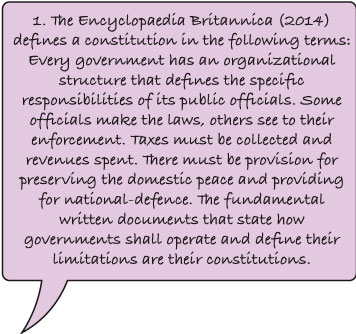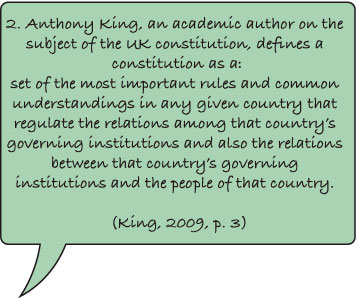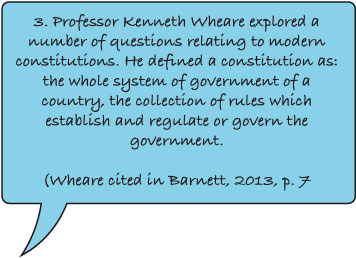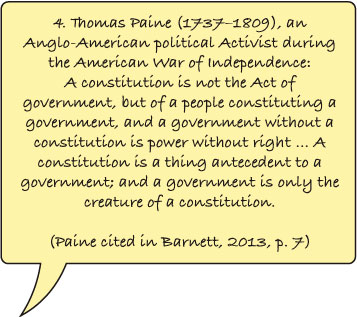1.1 What is a constitution?
The UK’s constitution is not contained in a written document but has developed and evolved in a piecemeal way over time.
In the media you may have come across or heard about the importance of ‘checks and balances’ on presidential or prime ministerial power. That phrase relates to constitutional arrangements within a state which you explore later.
The past 50 years has seen great constitutional change within the UK; the joining of the EU, the creation of the UK Supreme Court and devolution of the Nations. These changes have had a significant impact on the nature of the UK’s constitution and on the role of Scotland.
Activity 1 How would you define a constitution?
Consider the following quotations and using these as your source of information identify what features you think a constitution should have.




Comment
A range of state constitutions exists worldwide and each one is unique. A range of definitions also exist but at its most basic a state constitution is seen as having the following elements:
- rules about the structure and power of government of the state
- rules about the basic rights and freedoms of the citizens of that state
- rules on how law is created within that state.
States have their own legal systems and national laws which are created according to their constitution. Constitutions are fundamental to a society as they provide the structures which determine who has the right and the power to make and enforce the law. The constitution of each state also represents the history and culture of that state.
Looking at each of the definitions you were given as your source of information revealed different aspects of a state constitution and what features the authors thought ought to exist.
- The definition in The Encyclopaedia Britannica identifies the need for a structure, a definition of responsibilities, and different roles for different public officials is emphasised. The definition also links the notion of both peace and defence to a constitutional framework. You may have noticed that at the end of the definition it indicates that the constitution should be contained in a written form. This is an aspect that you will return to later.
- King’s definition focuses on the relations between governing institutions, but again mentions the relationship between the state (governing institutions) and individuals.
- Professor Wheare’s focuses on the regulation of the government by a system of rules. This definition has a narrower focus than the other definitions we have considered. There may at first glance appear to be a small difference; however, a constitution which is defined as regulating the state and state bodies has a wider scope than one which concentrates on regulation of the government.
The definitions discussed so far have considered the state, the government, and also the relationship between the state and individuals.
- Paine’s approach to defining a constitution provides a different perspective as it focuses on the source of a constitution. Paine’s view is that a constitution ultimately derives from the people acting through the government.
Another point to note is that definitions of a constitution tend to be neutral in their tone. They do not make a judgement as to whether the constitution is good or bad. Regimes such as Nazi Germany and the Soviet Union both had constitutions.
